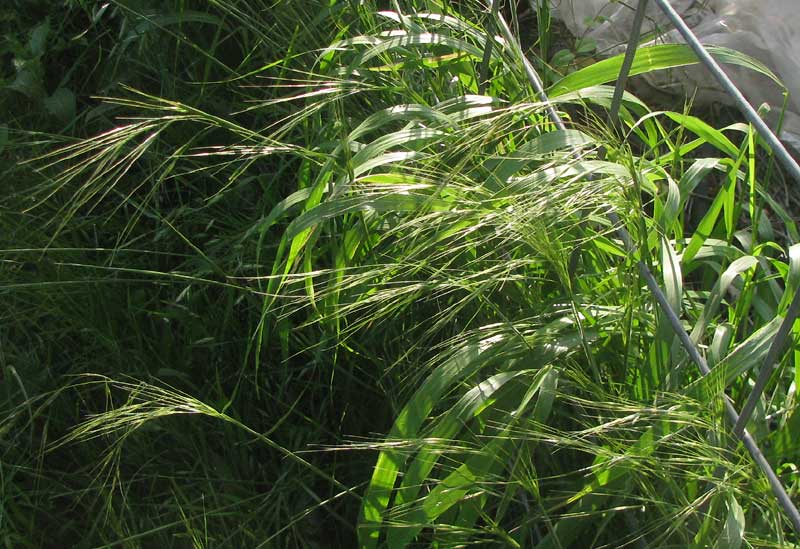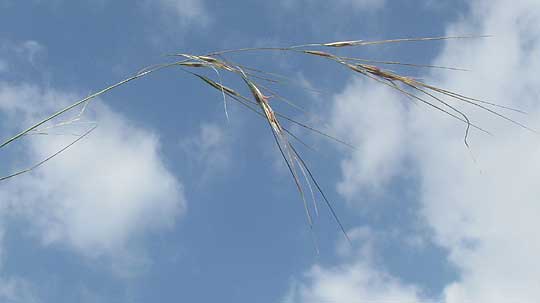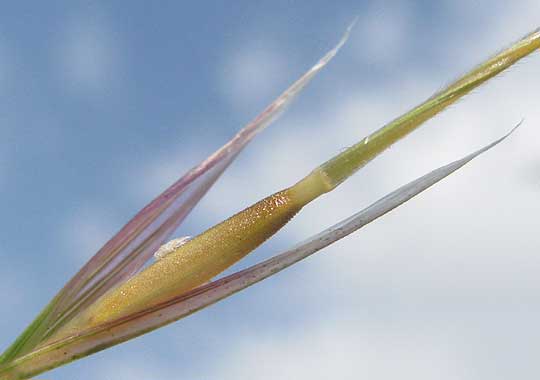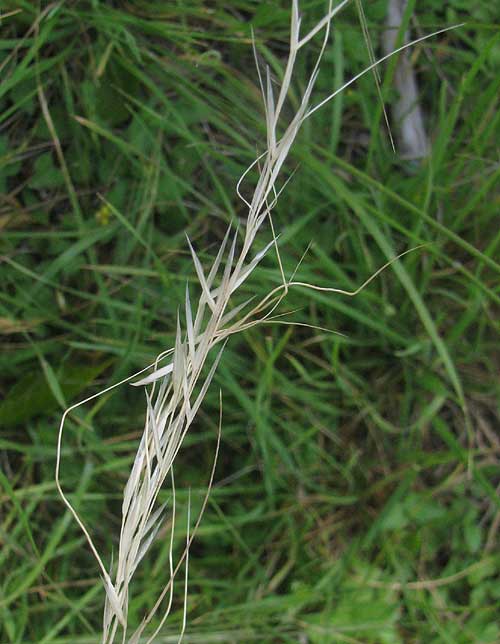Excerpts from Jim Conrad's
Naturalist Newsletter

from the the May 12, 2013 Newsletter issued from the Frio Canyon Nature Education Center in northern Uvalde County, southwestern Texas, on the southern border of the Edwards Plateau; elevation ~1750m (~5750 ft); N29.62°, W99.86°; USA
TEXAS NEEDLEGRASS
Behind the cabin nowadays a certain two-ft-tall grass (60cm) calls attention to itself by its abundance and by the way sunlight slanting in at dawn and dusk accentuates the grass flowers' long, stiff "awns," as displayed by a group leaning through the deer fence around my raised beds above.
Each flower's developing grain, or caryopsis-type fruit -- of which there's only one per flower, or spikelet -- bears an awn, and those long, stiff, slender awns are the special thing about this grass, making it easy to recognize. You can see how the needlelike awns stand out when you look closely at a grass's open panicle below:

A single spikelet showing a developing grain with its awn arising from a neck-like "crown," and the grain subtended by two slender, sharp-pointed, purplish glumes, can be seen below:

In that picture, notice how the base of the awn atop the grain twists. As grains mature and the grass dries out, the awns twist more and more, causing the awns to bend into odd shapes. Below you can see an older inflorescene with awns beginning to crook:

The awns' twistiness increases as the awns dry out but decreases when they are moistened. This causes the awns constantly to be changing their shapes, sometimes so fast you can see the movement. When a grain falls to the ground and undergoes humidity changes, the moving awns catch on nearby objects and in a somewhat haphazard fashion assist the grain in screwing itself into the soil.
In much of the southern US this interesting grass used to be a dominant species but now it's mainly found in Texas and contiguous states, and arid northeastern Mexico. It goes by several common names, including Texas Needlegrass, Texas Wintergrass and Texas Speargrass. It's NASSELLA LEUCOTRICHA. In literature of my younger days it was placed in the genus Stipa, and many sources still refer to it as Stipa leucotricha. About 116 species of Nassella are recognized, with the evolutionary center assumed to be South America, since that's where most species occur.
Texas Needlegrass not only produces regular florets which open to expose their stamens and stigmas for pollination -- the common condition of most flowers and known technically as "chasmogamy" -- but also "cleistogamous" ones, which remain closed and thus are not cross-pollinated. Studies show that the drier the soil, the more cleistogamous florets are produced. Since we're experiencing an extreme drought here I figured I could find cleistogamous florets on our grasses, but I couldn't.
In southwestern Texas this is an important grass, often found in prairie patches, brushy areas, roadsides and disturbed spots. It produces good forage for livestock during the winter, though the awns on the grains at this time of year can injure livestock mouths, sometimes having to be removed surgically.